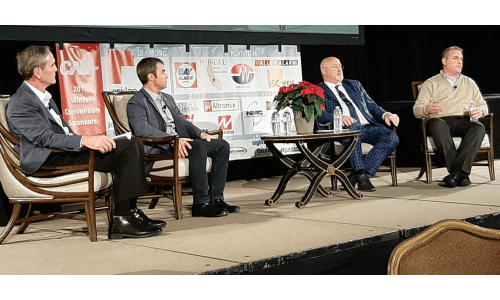
(l to r) CAA Executive Symposium Moderator George De Marco, I-View Now President Larry Folsom, OpenEye Executive Director Eric Fullerton and Ring Solutions President Mike Harris.
12.20.19 – SSI –
The 17th annual symposium delved into topics such as industry trends driven by disruptive technologies and business models challenging the status quo.
Moderating the executive symposium at the California Alarm Association (CAA) winter convention, George De Marco set the table by telling an audience of installing security contractors the aim of the session was to “make sure you hear what you need to hear rather than what you are hoping to hear.”
Now in its 17th year, the symposium, held here Dec. 6, delved into topics such as industry trends driven by disruptive technologies and business models challenging the status quo, as well as adaptability — or a lack thereof.
“One of the reoccurring themes that I see across the country in this industry is resistance to change. The hard part of change is taking the complex and making it a thoughtful, seamless and enjoyable customer experience,” De Marco said. “Especially as the flood of new products, services and go-to-market strategies hit the marketplace.”
Following brief company presentations by each panelist, De Marco sought to pinpoint the biggest challenges confronting the industry today, and the critical changes installing and monitoring companies need to make to remain effective.
Folsom highlighted the struggle for relevancy, and collaboration as a possible remedy. “The manufacturers that have traditionally served this space are being challenged by new entrants, they are being challenged by technology change. One of the challenges here is for the dealers and operators to actually help these manufacturers.”
Folsom invoked his entry into the market two decades ago working for a First Alert dealer. “They told us who our customer was, how to sell to them, how to install their product. Some of that [partnership] is getting lost. The traditional manufacturers aren’t necessarily leading the way in the space at this point.”
“Technology innovation has not been as quick as it could have been. When you see some of the new entrants and the technology they can bring to bear, there’s an opportunity to really move things quickly in that regard,” Harris said.
De Marco broached the topic of machine learning, deep learning and the wider context of artificial intelligence (AI). These technologies will eventually be used to more effectively process data and deliver richer solutions to end users. But will it be the security industry to innovate and capture the market opportunity?
Folsom is involved in developing a solution that analyzes various streams of sensor data from security systems, then assigns am automated confidence score that can help first responders determine whether or not to dispatch to an alarm event.
“I personally think this is the moment. It is imperative that we start adding machine learning to all of the streams that we have. And then we as an industry agree to what those scores are going to look like,” Folsom said. “So when we have that engagement, whether it’s programmatic or telephonically with 911, we’re able to transmit information that is going to help people use their resources better.”
“And that’s where the burden is on us. But it’s not going to be an independent thing. The artificial intelligence is going to be integrated into the applications as we know them today,” he said, “and create a return on investment and value for the end users and for the dealers.”
